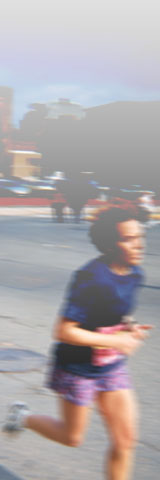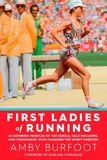


Injury Prevention
Cross Training | Massage | Strengthening | Stretching | Yoga
The key to a healthy lifestyle is to stay injury free in order to enjoy the full benefits of exercise. Stay healthy, increase your fitness level, and add variety to your workouts by incorporating cross training, massage, strength training, stretching, and yoga to your training program.
Our goal is to support your healthy, active, and injury free lifestyle. Here are tips, products, and advice designed to enhance your overall health and fitness:
Avoid Injury: Avoid the urge to run too much too soon, keep your training consistent, and remember to take time off if you feel any pain.
Causes of Injuries: The most common causes of running injuries are sudden, significant changes in the training routine, lack of proper rest between high intensity workouts, sudden increases in distance, workouts where you go too hard, or sudden changes in running surfaces.
Shin Splints: A painful injury that can force you to take time off from running, yet easy to prevent. *Do these stretches and exercises daily to recover from and prevent shin splints.* Stretch your calves, ankles, and feet - a slant board is ideal. Strengthen your shin muscles: Lean your back against a wall with your feet flat on the floor, approximately 8 to 10 inches away from the wall. Keep your back against the wall, lift toes up towards shins, slowly lower down. Works shins and calves. Never do this strengthening exercise before you walk or run. Optimal time for this exercise is after your workout or before bed.
General Health Benefits: Stiff joints? Back pain? Working out can help. Women can improve their general well-being and health with even moderate levels of exercise. An Australian study of almost 15,000 women concluded that those who exercise at least once a week for 20 minutes had more health benefits than women who did not. The more the women worked out, the more benefits they saw, especially in areas such as stiff joints, back pain, constipation, and mental health.
Hearing: Try running to improve your hearing. Cardiovascular exercise has shown to improve hearing levels in a Miami University of Ohio study. Twenty-four women and 19 men were tested, placed on a 20-week exercise program, and then re-tested. The result was a distinct improvement in their max VO2 and hearing sensitivity. The reason for this improvement is not clear, but is most likely due to improved circulation and healthier blood lipid profiles.
Ice: Prevent sore muscles and injuries by icing after a hard workout. If you already have an injury or pain, then it is even more important to ice to reduce inflammation and start the healing process.
Injury Prevention: Exercise can keep your muscles flexible and injury free as you age. In a University of Buffalo study done on the effects of muscle function in aging animals, endurance training in rats made their muscles more resistant to injury than muscles in sedentary rats.
Keep Blood Vessels Young: A University of Pisa study found that the blood vessels of older athletes function as well as blood vessels of younger athletes. Exercise helps maintain the inner lining of the blood vessels. The study compared groups of long distance runners, cyclists, and triathletes who were 27 years old and 66 years old. The regular physical activity keeps the protective layer healthy, which can also reduce the risk of heart attacks and the chances of blockage in your arteries.
Low Back: About 75 million people in the U.S. have recurring back pain. The best way to rid yourself of recurring back pain, according to the American College of Sports Medicine, is with a balance of abdominal exercises and lower back exercises. The focus on abs alone to strengthen the front and back of the midsection is not enough. It is important to strengthen the whole core body.
New Runner's Tip: Avoid doing too much, too soon. New runners often feel great starting a new training schdule or workout routine and want to jump right in! Doing too much too soon can lead to injuries. Start easy and increase your mileage by no more than 10% per week. You'll be injury free and happier in the long run.
Plantar Fasciitis: Don't let foot and heel pain slow you down! Stretch your calves, feet, and ankles regularly. Massage will also help loosen up tight muscles and increase blood flow to the sore area. Strengthen your foot muscles. Place a towel on the floor lengthwise in front of your bare feet. Using your toes, grab the part of the towel closest to you and pull it toward you. Release, straighten the towel, then grab and pull again. Supportive shoes and avoiding walking around barefoot are important during the healing process.
Recovery: Rest and recovery days are important to your training schedule. Rest days should be spread out and not taken consecutively. Recovery days such as easy short runs, easy long runs, or easy cross training days should be just that, easy! Save your intensity for the hill workouts, track workouts, tempo runs, intervals, fartlek, and races.
Rest: Rest is crucial to the treatment of an injury. Complete rest is sometimes required, and in other cases, changing the form of exercise is enough to allow the injured area to rest and heal.
Side Stitches: There are many ways to get rid of or at least reduce those annoying and sometimes painful side stitches. Try these to find out which work best for you - breathe through pursed lips, belly breathe, contract the abdominal muscles and press into the painful area.
Stronger Bones: Running can help you build stronger bones. The University of Edinburgh study showed that among male athletes, runners had greater bone density than cyclists and the control group of non-exercisers. The cyclists had reduced spine density, but greater bone density in their arms. The athletes who participated in both cycling and running had greater leg and arm bone density due to the diversity of training and greater use of upper body weight training. Source: Medicine & Science in Sports & Exercise August 2000
Tendon Trouble: Antibiotics usually cure you, but some have been linked to ruptured tendons. The antibiotic fluoroquinolones helps cure infections such as urinary tracts, soft tissues, respiratory, or bone and joint infections. *Be careful of its strength.* Spontaneous tendon ruptures can occurs during or shortly after treatment with this antibiotic, most commonly affecting the Achilles tendon.
Yoga: Although yoga and running lie on opposite ends of the exercise spectrum, the two need not be mutually exclusive. Runners often experience bad backs and knees, tight hamstrings, and sore feet. It's not surprising, during the course of an average mile run, your foot will strike the ground 1,000 times. The force of impact on each foot is about three to four times your weight. All sports injuries are caused by imbalances. The pain most runners feel is not from the running in and of itself, but from imbalances that running causes and exacerbates. If you bring your body into balance through the practice of yoga, you can run long and hard for years to come. To increase range of motion, agility, flexibility, lung capacity, endurance, and strength, click here.
Injury Prevention
Cross Training | Massage | Strengthening | Stretching | Yoga
|
For Email Marketing you can trust
|

|

|

RunnerGirl Bookstore |

|
|
|

